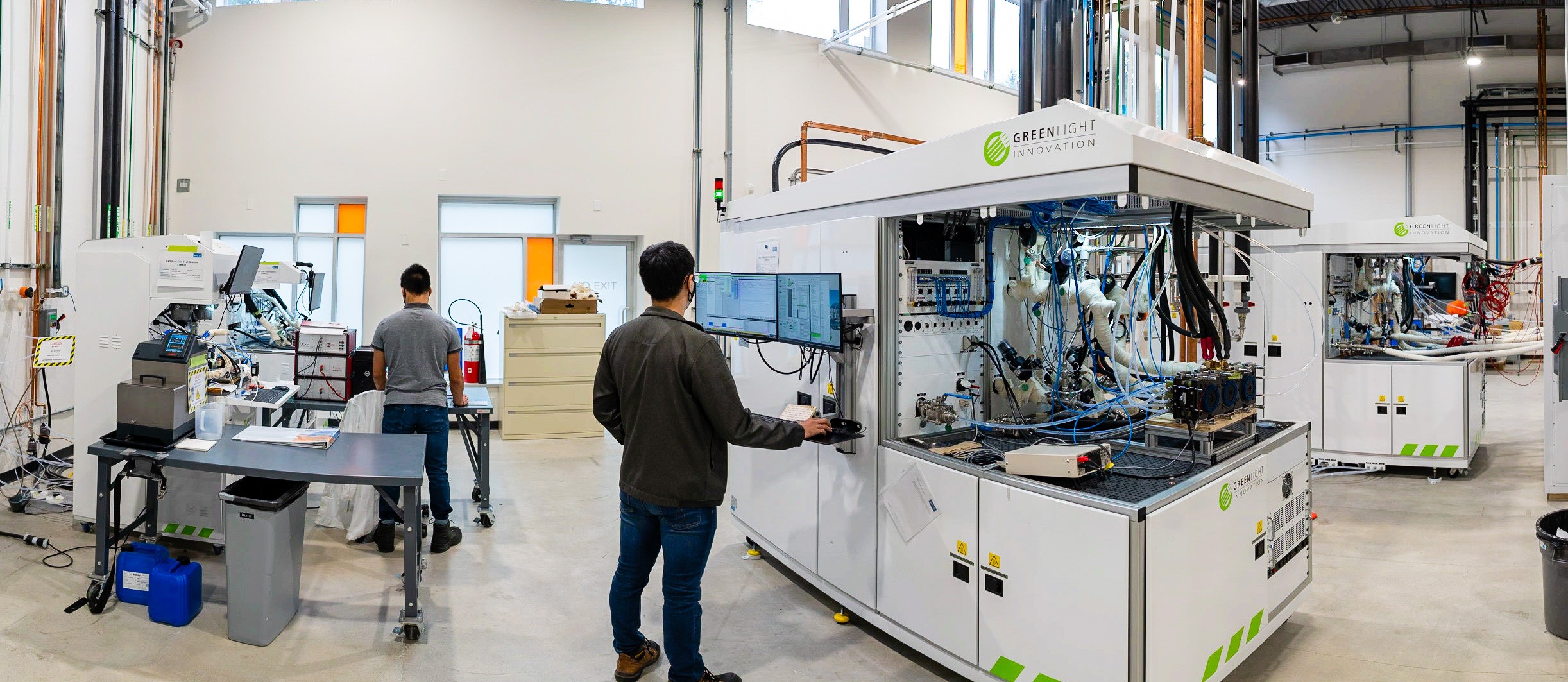- What is the purpose of fuel cell stack testing?
- Which type of tests are usually performed in which development phase?
- Which criteria are generally tested in a fuel cell stack testing?
- What are Accelerated Stress Tests (ASTs)?
- What are Life-Cycle Tests (LCTs)?
- What is a Design Validation Plan & Report (DVP&R)?
- What are Freeze Start-Up (FSU) Tests (-30 °C)?
- What are Freeze-Thaw Tests?
- What is a Sub-Scale Characterization?
- What is Single-Cell Testing?
- What is Short Stack Testing?
- What is Full Size Stack Testing?
- What is Leak Testing?
- What is Bleed-Down Testing Start-Up/Shut-Down Testing?
- What is Degradation testing?
- What is Ex-Situ testing?
- What is Stack & Cell Benchmarking?
- How does the operating environment affect the type of tests performed and the requirements to be met by a fuel cell stack?
- Which are the recommended fuel cell industry standards for state-of-the-art fuel cell stack testing?
Browse all fuel cell stack testing services from leading companies on our marketplace!
What is the purpose of fuel cell stack testing?
Testing of fuel cell stacks can have a variety of objectives.
- Characterization of the fuel cell components and materials (catalyst, membrane, GDL,…) to find the effective catalyst surface area (ECSA), particle size/roughness factor,…).
- Determining sub-scale parameters for model inputs (transfer coefficient/alpha-n, empirical rate constant/ko, reaction order/g,…).
- Performance testing (polarization curve from no load (OCV/open circuit voltage) to full load (max current density).
- Robustness testing – running the stack under cool (warm-up), cold (sub-zero), or hot conditions, or with contamination or other off-spec conditions (dry, flooded, etc.).
- Drive cycle testing – to determine how a stack behaves under a given drive cycle (load profile, degradation, application specific).
Which type of tests are usually performed in which development phase?
- At concept level, mostly perform sub-scale testing for characterization of materials.
- At prototype level, test with short stacks (10-cell or 20-cell stacks) for performance testing and robustness testing.
- At more mature sample phases, test full size stacks for drive cycle operation, design verification/validation, and customer-specific tests (for a given application).

Fuel Cell Stack Testing Laboratory at AVL Fuel Cell Canada
Which criteria are generally tested in a fuel cell stack testing?
General output data for fuel cell stack testing are:
- Average cell voltage (ACV) over a full load range (pol curves)
- Sensitivity results (variation of pressure, temperature, relative humidity, stoich,…).
- Degradation (micro-volts/cell/hour).
- Parameters (ECSA, alpha-n, ko, g …)
What are Accelerated Stress Tests (ASTs)?
- Purpose: apply stressors to the stack in an accelerated manner to reduce total testing time.
- Test method: Varies (e.g. OCV test, SU/SD cycling, run hot/dry conditions,…)
- Equipment required: Fuel Cell Test Station
What are Life-Cycle Tests (LCTs)?
- Purpose: Mimic a real drive cycle to apply realistic stressors to the stack for lifetime estimation.
- Test method: Require real data from application to apply to the stack (load cycle, power curves, environmental conditions, etc.).
- Equipment required: Fuel Cell Test Station with programmable load cycle capability.
What is a Design Validation Plan & Report (DVP&R)?
- Purpose: Validate (and verify) the stack design.
- Test method: A complete suite of tests to prove the stack meets all its requirements.
- Equipment required: Test stations (ASTs/LCTs), freeze chamber, shaker table, etc.
What are Freeze Start-Up (FSU) Tests (-30 °C)?
- Purpose: Test the capability of the stack to start and operate from sub-zero temperatures.
- Test method: Use a specific FSU protocol (including system and stack purge) to FSU stack.
- Equipment required: Fuel Cell Test Station and freeze chamber.
What are Freeze-Thaw Tests?
- Purpose: Check effects of freezing and thawing water in the stack (non-operational).
- Test method: Cycle stack between freezing conditions and ambient conditions.
- Equipment required: Freeze chamber.
What is a Sub-Scale Characterization?
- Purpose: Materials and parameter characterization of small scale samples (10 – 50 cm2 active area).
- Test method: Cyclic Voltammetry/CV, SEM, TEM, EDS/EDX, FIB, 0.9V iR-free Cell Voltage,…
- Equipment required: Sub-scale test station, SEM, TEM, EDX/EDX, FIB.
What is Single-Cell Testing?
- Purpose: Single cell performance and characterization
- Test method: Test one unit cell (full size) to determine fuel cell stack efficiency.
- Equipment required: Single cell or short stack test station.
What is Short Stack Testing?
- Purpose: Run stacks with 10-cells or 20-cells (pols, ASTs, LCTs, sensitivity tests, …)
- Test method: Run same tests as for a full size stack, but with a short stack (especially if degradation or damage/destructive testing is needed, using short stacks is better for cost reasons alone).
- Equipment required: Short Stack Test Station.
What is Full Size Stack Testing?
- Purpose: Operation of a full size stack (50-500+ cells) for characterization, verification, validation. Can check for header effects, tilt/inclination, and other factors that are not possible in short stack testing.
- Test method: Run the full size module on a test station under the specified conditions.
- Equipment required: Full size stack test station (50-150+ kW).
What is Leak Testing?
- Purpose: Determine if the stack has any fuel/Fx (hydrogen), oxidant/Ox (air), or coolant/Cx (de-ionized water or water-ethylene-glycol) leaks.
- Test method: Test each circuit individually (total external, Fx external, Ox external, Cx external, Fx->Ox internal, Fx->Cx internal, Ox->Cx internal).
- Equipment required: Leak test station.
What is Bleed-Down Testing Start-Up/Shut-Down Testing?
- Purpose: Determine if a cell (or cells) are leaking, have shorting effect, or other damage.
- Test method: Monitor the cell bleed down from operation to zero volts using the cell voltage monitoring system (CVM).
- Equipment required: Test station with CVM logging capability.
What is Degradation testing?
- Purpose: Running specific tests (AST, LCT,…) and determine the performance degradation of the stack. Can be long tests to fully characterize degradation.
- Test method: Run the specified conditions and monitor the stack voltage as well as cell voltages over time.
- Equipment required: Stack test station with CVM logging capability.
What is Ex-Situ testing?
- Purpose: Ex-situ testing is examining smaller samples outside of the fuel cell stack.
- Test method: Can be any laboratory method (optical, SEM, TEM, EDS/EDX, FIB, etc.).
- Equipment required: Laboratory equipment to conduct the specified test.
What is Stack & Cell Benchmarking?
- Purpose: Benchmarking is comparing one stack against another (or one manufacturer against another).
- Test method: Run both (or several) stacks under the same conditions to compare them.
- Equipment required: Fuel Cell Stack Test Stations.
How does the operating environment affect the type of tests performed and the requirements to be met by a fuel cell stack?
Different applications of fuel cell stack technology have different operating environments. A stack in an ice-breaker may have to deal with sub-zero conditions and harsh shock & vibration. A stack in a desert dune buggy may have to deal with high temperatures and dust ingress. The fuel cell components and materials used in each application must be tested within their respective environmental conditions.
Take a tour in the test facility of AVL Canada
Which are the recommended fuel cell industry standards for state-of-the-art fuel cell stack testing?
Each application of fuel cell technology will have its own set of industry standards that must be complied with. Some industries already have advanced fuel cell standards (automotive industry), while others are new to fuel cells and have very few standards (marine industry). Each different region will also have its own set of standards that require certification (e.g. Europe, North America, Japan, China,…).
Content contributed by AVL Fuel Cell Canada
AVL Fuel Cell Canada performs cutting edge PEM (proton exchange membrane) fuel cell development for all applications, including automotive, heavy duty and marine. We leverage the knowledge of top fuel cell experts for our clients. We work with leading OEMs (original equipment manufacturers) with the target of developing or improving PEM fuel cell stack designs. We offer state of the art PEM fuel cell testing services, including performance, degradation and characterization tests in line with international testing standards.
Last update: 15.01.2023


